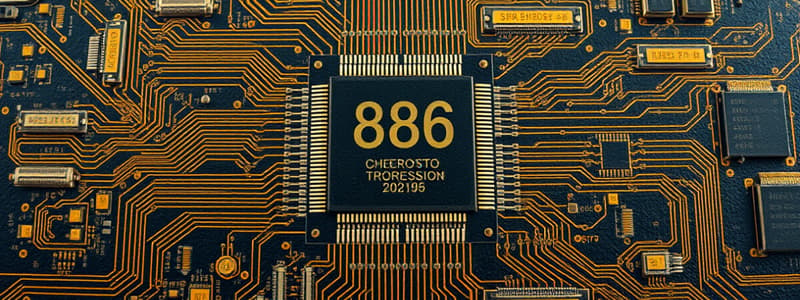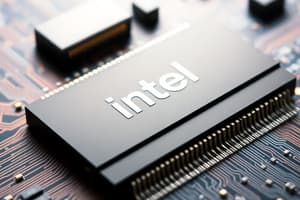Podcast
Questions and Answers
What is the maximum amount of memory that the 8086 can access?
What is the maximum amount of memory that the 8086 can access?
- 512 KB
- 2 MB
- 4 MB
- 1 MB (correct)
Which of the following is not a feature of the 8086 microprocessor?
Which of the following is not a feature of the 8086 microprocessor?
- Supports 64K I/O ports
- Operates with a 33% duty cycle clock
- Uses a 40-pin dual in-line package
- Includes 32-bit registers (correct)
What are the two blocks that make up the architecture of the 8086?
What are the two blocks that make up the architecture of the 8086?
- Control Unit and Arithmetic Logic Unit
- Data Unit and Memory Unit
- Execute Unit and Bus Interface Unit (correct)
- Core Unit and Management Unit
What is the primary function of the Bus Interface Unit (BIU) in the 8086?
What is the primary function of the Bus Interface Unit (BIU) in the 8086?
How does the 8086 achieve instruction execution efficiency?
How does the 8086 achieve instruction execution efficiency?
Which component of the 8086 is responsible for maintaining the instruction queue?
Which component of the 8086 is responsible for maintaining the instruction queue?
What voltage supply is required for the operation of the 8086 microprocessor?
What voltage supply is required for the operation of the 8086 microprocessor?
How many bytes of instruction can the 8086 pre-fetch from memory at one time?
How many bytes of instruction can the 8086 pre-fetch from memory at one time?
What does the status signal S5 indicate?
What does the status signal S5 indicate?
What is the function of the BHE signal during data transfers?
What is the function of the BHE signal during data transfers?
How does the RESET signal affect the operation of the processor?
How does the RESET signal affect the operation of the processor?
What does a logic 1 on the M/IO signal indicate?
What does a logic 1 on the M/IO signal indicate?
Which signal is used to indicate whether data needs to be transmitted or received?
Which signal is used to indicate whether data needs to be transmitted or received?
When does the Address Latch Enable (ALE) become logic 1?
When does the Address Latch Enable (ALE) become logic 1?
What occurs when the TEST input goes low?
What occurs when the TEST input goes low?
Which of the following best describes the behavior of status signals S4 and S3?
Which of the following best describes the behavior of status signals S4 and S3?
What does the 8086 microprocessor do during period T3 of a memory read cycle?
What does the 8086 microprocessor do during period T3 of a memory read cycle?
What does the WR signal indicate during T2 of a memory write cycle?
What does the WR signal indicate during T2 of a memory write cycle?
Which signals are activated at T1 to initiate a write cycle in the 8086?
Which signals are activated at T1 to initiate a write cycle in the 8086?
When does the 8086 switch RD to inactive logic level during a read cycle?
When does the 8086 switch RD to inactive logic level during a read cycle?
What role does DEN play during the memory operation of the 8086?
What role does DEN play during the memory operation of the 8086?
What occurs during the T1 time state of the 8086 bus cycle?
What occurs during the T1 time state of the 8086 bus cycle?
What signal indicates a read cycle is in progress during T2?
What signal indicates a read cycle is in progress during T2?
Which signal remains active throughout the four periods of the bus cycle?
Which signal remains active throughout the four periods of the bus cycle?
How is the address latched in external circuitry during T1?
How is the address latched in external circuitry during T1?
What is a group of states in the 8086 bus cycle referred to as?
What is a group of states in the 8086 bus cycle referred to as?
Which of the following statements about the status bits during T2 is true?
Which of the following statements about the status bits during T2 is true?
What action takes place in case the reader input is not activated before T3?
What action takes place in case the reader input is not activated before T3?
During which time states does the status bit S0 to S2 remain active?
During which time states does the status bit S0 to S2 remain active?
What is the purpose of the Count Register in the 8086 architecture?
What is the purpose of the Count Register in the 8086 architecture?
In the context of the Data Register, what role does the DH register play?
In the context of the Data Register, what role does the DH register play?
What is the primary function of the Instruction Pointer (IP) register?
What is the primary function of the Instruction Pointer (IP) register?
Which of the following correctly describes the Stack Pointer (SP) register?
Which of the following correctly describes the Stack Pointer (SP) register?
Which registers are involved in indexed addressing for data in the stack segment?
Which registers are involved in indexed addressing for data in the stack segment?
How many bits are utilized in the Flag Register of the 8086 architecture for condition flags?
How many bits are utilized in the Flag Register of the 8086 architecture for condition flags?
What does the Source Index (SI) register primarily facilitate?
What does the Source Index (SI) register primarily facilitate?
What is the combined function of the CL and CH registers?
What is the combined function of the CL and CH registers?
Study Notes
Introduction to 8086 Microprocessors
- 8086 is a 16-bit microprocessor with a 20-bit address bus, allowing access to 1 MB of memory (2^20 memory locations).
- Supports up to 64K I/O ports and provides 14 registers, each 16-bits in size.
- Utilizes a multiplexed address and data bus (AD0-AD15 and A16-A19).
- Operates with a +5V power supply in a 40-pin dual in-line package.
Architecture of 8086 Processors
- Comprises two main units: Bus Interface Unit (BIU) and Execution Unit (EU).
- BIU handles all bus operations, instruction fetching, operand reading/writing, and address calculations.
- EU executes instructions from the instruction queue, enabling pipelining for enhanced efficiency.
Register Organization of 8086
- The count register (CX) consists of two 8-bit registers (CL and CH), used for loop and string manipulation.
- Data register (DX) comprises two 8-bit registers (DL and DH), utilized for I/O operations and arithmetic calculations.
- Contains general-purpose registers: Stack Pointer (SP), Base Pointer (BP), Source Index (SI), Destination Index (DI), and Instruction Pointer (IP).
Memory Segmentation of 8086
- 8086 employs memory segmentation for efficient memory management.
- Segment registers assist in the organization of memory for code, data, and stack segments.
- Memory addressing combines the contents of segment registers and the instruction pointer.
Pin Diagram of 8086
- The pin configuration supports a variety of functions, including addressing and data transfer.
- Key signals: ALE (Address Latch Enable), M/IO (memory/I/O operation), DT/R (data transmit/receive), and RESET for processor initialization.
Timing Diagrams for 8086
- Bus cycles involve specific time states (T1-T4) crucial for memory read/write operations.
- A memory read cycle outputs a 20-bit address in T1 and enables data transfer in T3.
- A memory write cycle follows a similar sequence, with data being transmitted during T2 and maintained until T4.
Interrupts of 8086
- 8086 supports interrupts for managing processor priorities and event handling.
- Interrupt Enable Flag (IF) is used to control interrupt handling status.
Control Signals and Timing States
- Control signals like ALE indicate valid address presence, while M/IO signals if the operation is memory or I/O related.
- Data direction is signaled by DT/R, where logic 1 indicates data transmission.
Summary of Operations
- Instruction cycle timing is determined by specific machine cycles which vary based on the operation (memory read, memory write, etc.).
- The combined architecture of BIU and EU allows for simultaneous instruction fetch and execution, optimizing performance through pipelining.
Studying That Suits You
Use AI to generate personalized quizzes and flashcards to suit your learning preferences.
Description
This quiz covers Unit II of the Microprocessors and Microcontrollers course, focusing on the 8086 microprocessor. It includes topics such as its architecture, register organization, memory segmentation, and interrupts, providing a comprehensive overview of the 8086's functionalities.




